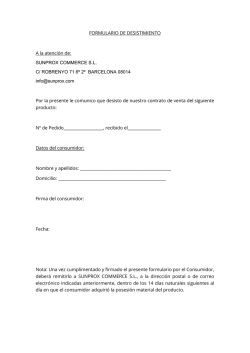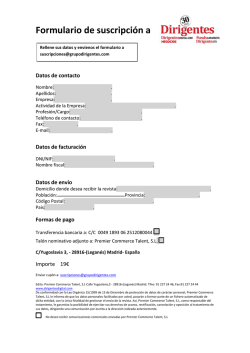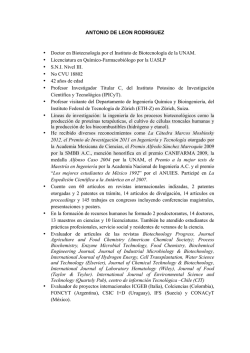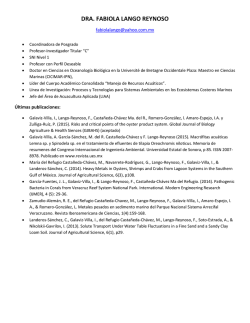
Análisis de la alizar comercio social - RiUMA
Análisis de la intención de realizar comercio social en webs con herramientas sociales Sebastian Molinillo, Profesor Titular, Departamento de Economía y Administración de Empresas, Facultad de Ciencias Económicas y Empresariales, Universidad de Málaga, Campus El Ejido, 29071 Málaga (España), [email protected], +34952131265. Francisco Liébana-Cabanillas, Profesor Contratado Doctor, Departamento de Comercialización e Investigación de Mercados, Facultad de Ciencias Económicas y Empresariales, Universidad de Granada, Campus Universitario de Cartuja, 18071 Granada (España), [email protected], + 958242380. Rafael Anaya-Sánchez, Profesor Asociado, Departamento de Economía y Administración de Empresas, Facultad de Ciencias Económicas y Empresariales, Universidad de Málaga, Campus El Ejido, 29071 Málaga (España), [email protected], +34952131265. Resumen El comercio social, o comercio a través de los medios sociales (también conocido como social commerce) es una de las modalidades de comercio electrónico con mayor potencial de crecimiento. Sin embargo, su estudio aún es limitado, por lo que las dinámicas y elementos que afectan a la intención de realizar comercio social requieren de una mayor investigación. La bibliografía existente principalmente analiza la intención de los usuarios de practicar comercio social en una red social, pero no en una web de comercio electrónico que tenga sus propias herramientas sociales (p. ej. foros, valoraciones de productos, etc.). Por lo tanto, la presente investigación tiene como objetivo identificar los antecedentes de la intención de comercio social en webs de comercio electrónico en las que se emplean herramientas sociales. A partir de la revisión de la literatura, se desarrolla un modelo para analizar la influencia de cinco posibles antecedentes de la intención de comercio social: calidad de la web, apoyo social emocional, apoyo social informativo, presencia social e inmersión o flow. Para ello, se realizó un estudio empírico entre los usuarios de una web de comercio electrónico que cuenta con un sistema de valoración, comentarios de productos y foros. Los datos se obtuvieron a partir de una encuesta realizada a 200 compradores, y fueron analizados mediante la técnica PLS. Los resultados indican que los elementos más racionales y emocionales de la experiencia del usuario, como son la calidad del sitio web, flow y el apoyo social emocional, son los que motivan la compra; mientras que la presencia social y el apoyo social informativo, no son significativos. Este estudio contribuye a la teoría del comportamiento del consumidor al aplicar variables predictivas de la intención de comercio social a webs con herramientas sociales. Además, los resultados ayudan a los profesionales del comercio electrónico a mejorar el uso que hacen de las herramientas sociales. Palabras clave: comercio social, calidad de la web, flow, apoyo social, presencia social. Comunicación presentada en: 16th International Marketing Trends Conference, 26th-28th January 2017, Madrid. 1 Bibliografía Ajzen, I. (1991). The theory of planned behaviour. Organizational Behaviour and Human Decision Process, 50(2), 179-211. Ajzen, I., y Fishbein, M. (1980). Understanding attitudes and predicting social behaviour. New Jersey: Prentice Hall. Animesh, A., Pinsonneault, A., Yang, S.-B., y Oh, W. (2011). An odyssey into virtual worlds: Exploring the impacts of technological and spatial environments on intention to purchase virtual products. MIS Quarterly, 35(3), 789-810 Barclay, D., Higgins, C., y Thompson, R. (1995). The partial least squares (PLS) approach to causal modeling: Personal computer adoption and use as an illustration. Technology Studies, 2(2), 285-309. Barroso Castro, M. C., Cepeda Carrión, G. A., y Roldán, J. L. (2007). Constructos latentes y agregados en la economía de la empresa. In Decisiones basadas en el conocimiento y en el papel social de la empresa: XX Congreso anual de AEDEM (p. 67). Asociación Española de Dirección y Economía de la Empresa (AEDEM). Beltrán, L. S., & Blanco, J. E. E. (2016). Análisis del estudio de las relaciones causales en el marketing. Revista Innovar Journal, 26(62), 79-94. Blau, P. (1964). Exchange and Power in Social Life. New York: John Wiley & Sons. Chen, J., y Shen, X.-L. (2015). Consumers' decisions in social commerce context: An empirical investigation. Decision Support Systems, 79, 55-64. Chin, W. W. (1998). The partial least squares approach to structural equation modeling. In G. A. Marcoulides, (Ed), Modern methods for business research (pp. 295-336). Mahwah, NJ, US: Lawrence Erlbaum Associates Publishers Modern methods for business research, Choi, J., Lee, H. J., y Kim, Y. C. (2011). The Influence of Social Presence on Customer Intention to Reuse Online Recommender Systems: The Roles of Personalization and Product Type. International Journal of Electronic Commerce, 16(1), 129-154. Constantinides, E., y Fountain, S. J. (2008). Web 2.0: conceptual foundations and marketing issues. Journal of Direct, Data and Digital Marketing Practice, 9(3), 231-244 Crocker, J., y Canevello, A. (2008). Creating and undermining social support in communal relationships: The role of compassionate and self-image goals. Journal of Personality and Social Psychology, 95(3), 555-575. Cronbach, L. J. (1951). Coefficient alpha and the internal structure of tests. Psychometrika, 16(3), 297-334. Curty, R. y Zhang, P. (2011). Social Commerce: Looking Back and Forward. Artículo presentado en ASIST 2011, October 9–13, 2011 New Orleans, LA, USA. Diamantopoulos, A., & Winklhofer, H. M. (2001). Index construction with formative indicators: An alternative to scale development. Journal of Marketing Research, 38(2), 269277. Falk, R. F., y Miller, N. B. (1992). A primer for soft modeling. University of Akron Press. Fornell, C., y Larcker, D. F. (1981). Evaluating structural equation models with unobservable variables and measurement error. Journal of Marketing Research, 18(1), 39-50. Gefen, D., y Straub, D. W. (2004). Consumer trust in B2 C e-commerce and the importance of social presence: experiments in e-Products and e-Services. Omega, 2(6), 407-424. Geisser, S. (1975). The predictive sample reuse method with applications. Journal of the American Statistical Association, 70(350), 320-328. Gu, B., Park, J., y Konana, P. (2012). The impact of external word-of-mouth sources on retailer sales of high-involvement products. Information Systems Research, 23(1) 182-196. Guo, Y., y Barnes, S. (2007). Why People Buy Virtual Items in Virtual Worlds with Real Money. The DATA BASE for Advances in Information Systems, 38(4), 69-76. 2 Guo, Y. M., y Poole, M. S. (2009). Antecedents of flow in online shopping: a test of alternative models. Information Systems Journal, 9(4), 369-390. Hausman, A. V., y Siekpe, J. S. (2009). The effect of web interface features on consumer online purchase intentions. Journal of Business Research, 2(1), 5-13. Hennig-Thurau, T., Hofacker, C. F., y Bloching, B. (2013). Marketing the pinball way: understanding how social media change the generation of value for consumers and companies. Journal of Interactive Marketing, 27, 237-241. Henseler, J., Dijkstra, T. K., Sarstedt, M., Ringle, C. M., Diamantopoulos, A., Straub, D. W., y Calantone, R. J. (2014). Common beliefs and reality about PLS comments on Rönkkö and Evermann (2013). Organizational Research Methods, 17(2), 182-209. Henseler, J., Ringle, C. M., y Sarstedt, M. (2015). A new criterion for assessing discriminant validity in variance-based structural equation modeling. Journal of the Academy of Marketing Science, 43(1), 115-135. Hoffman, D. L., y Novak, T. P. (1996). Marketing in hypermedia computer-mediated environments: conceptual foundations. Journal of Marketing, 60(3), 50-68. Huang, K.-Y., Nambisan, P., y Uzuner, Ö. (2010). Informational support or emotional support: Preliminary study of an automated approach to analyze online support community contents. Artículo presentado en el International Conference on Information Systems (ICIS 2010), St. Louis, MO, December 12–15. Huang, Z., y Benyoucef, M (2013). From e-commerce to social commerce: A close look at design features. Electronic Commerce Research and Applications, 12, 246-259. Kim, S., y Park, H. (2013). Effects of various characteristics of social commerce (scommerce) on consumers’ trust and trust performance. International Journal of Information Management, 33, 318-332. Koufaris, M. (2002). Applying the technology acceptance model and flow theory to online consumer behavior. Information Systems Research, 13(2), 205-223. Liang, T. P., Ho, Y.-T., Li, Y. W., y Turban, E. (2011). What Drives Social Commerce: The Role of Social Support and Relationship Quality. International Journal of Electronic Commerce, 16(2), 69-90. Liu, H., Chu, H., Huang, Q., y Chen, X. (2016). Enhancing the flow experience of consumers in China through interpersonal interaction in social commerce. Computers in Human Behavior, 58, 306-314. Lu. B., Fan, W., y Zhou, M. (2016). Social presence, trust, and social commerce purchase intention: An empirical research. Computers in Human Behavior, 56. 225-237. Mamoun, M. M. A. D., y Ashouri, N. A. M. I. (2015). Consumer attitudes towards online shopping. Internet Research, 25(5), 707-733. Mardsen, P. (2010). Social Commerce: monetizing social media. Hamburg, Germany: Syzygy Deutschland Gmbh. Novak, T. P., Hoffman, D. L., y Yung, Y.-F. (2000). Measuring the customer experience in online environments: a structural modeling approach. Marketing Science, 9(1), 22-42. Nunnally, J. C., y Bernstein, IH (1994). Psychometric theory. New York: McGraw-Hill. Petter, S., Straub, D., y Rai, A. (2007). Specifying formative constructs in information systems research. Mis Quarterly, 31(4), 623-656. Porter, C. E., y Donthu, N. (2008). Cultivating trust and harvesting value in virtual communities. Management Science, 54(1), 113-128. Qiu, L., y Benbasat, I. (2005). An investigation into the effects of Text-To-Speech voice and 3D avatars on the perception of presence and flow of live help in electronic commerce. ACM Transactions on Computer-Human Interaction, 2(4), 329-355. Ringle, C. M., Wende, S., y Becker, J. M. (2015). SmartPLS 3. Bönningstedt: SmartPLS. 3 Sallnas, E. L., Rassmus-Grohn, K., y Sjostrom, C. (2000). Supporting presence in collaborative environments by haptic force feedback. ACM Transactions on ComputerHuman Interaction, 7(4), 461-476. Stone, M. (1974). Cross-validatory choice and assessment of statistical predictions. Journal of the Royal Statistical Society. Series B (Methodological), 36(2), 111-147. Tang, Q., Gu, B., y Whinston, A. B. (2012). Content contribution for revenue sharing and reputation in social media: a dynamic structural model. Journal of Management Information Systems, 9(2), 41-76. Venkatesh, V., & Davis, F. D. (2000). A theoretical extension of the technology acceptance model: four longitudinal field studies. Management Science, 6(2), 186-204. Wang, C., & Zhang, P. (2012). The evolution of social commerce: the people, management, technology, and information dimensions. Communications of the Association for Information Systems, 31(5), 105-127. Wang, Z., Li, H., Ye, Q. &, Law, R. (2016). Saliency effects of online reviews embedded in the description on sales: Moderating role of reputation. Decision Support Systems, 87, 50-58. Xie, B. (2008). Multimodal computer-mediated communication and social support among older Chinese Internet users. Journal of Computer-Mediated Communication, 13(3), 728-750. Zhang, H., Lu, Y., Gupta, S., & Zhao, L. (2014). What motivates customers to participate in social commerce? The impact of technological environments and virtual customer experiences. Information & Management, 51, 1017-1030. Zhang, K. Z. K., & Benyoucef, M. (2016). Consumer behavior in social commerce: A literature review. Decision Support Systems, 86, 95-108. Zhou, L., Zhang, P., & Zimmermann, H.-D. (2013). Social commerce research: an integrated view. Electronic Commerce Research and Applications, 12(2), 61-68. 4
© Copyright 2026




